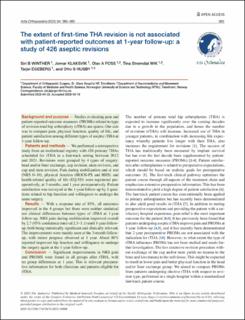| dc.contributor.author | Winther, Siri Bjørgen | |
| dc.contributor.author | Klaksvik, Jomar | |
| dc.contributor.author | Foss, Olav A. | |
| dc.contributor.author | Wik, Tina Strømdal | |
| dc.contributor.author | Egeberg, Tarjei | |
| dc.contributor.author | Husby, Otto Schnell | |
| dc.date.accessioned | 2023-11-15T07:57:59Z | |
| dc.date.available | 2023-11-15T07:57:59Z | |
| dc.date.created | 2023-08-24T09:16:19Z | |
| dc.date.issued | 2023 | |
| dc.identifier.citation | Acta Orthopaedica. 2023, 94 360-365. | en_US |
| dc.identifier.issn | 1745-3674 | |
| dc.identifier.uri | https://hdl.handle.net/11250/3102609 | |
| dc.description.abstract | Background and purpose: Studies evaluating pain and patient-reported outcome measures (PROMs) related to type of revision total hip arthroplasty (rTHA) are sparse. Our aim was to compare pain, physical function, quality of life, and patient satisfaction among different types of aseptic rTHA at 1-year follow-up.
Patients and methods: We performed a retrospective study from an institutional registry with 426 primary THAs scheduled for rTHA in a fast-track setting between 2012 and 2021. Revisions were grouped by 4 types of surgery: head and/or liner exchange, cup revision, stem revision, and cup and stem revision. Pain during mobilization and at rest (NRS 0–10), physical function (HOOS-PS and HHS) and health-related quality of life (EQ-5D) were registered preoperatively, at 3 months, and 1 year postoperatively. Patient satisfaction was surveyed at the 1-year follow-up by 2 questions related to hip function and willingness to undergo the same surgery.
Results: With a response rate of 85%, all outcomes improved in the 4 groups but there were neither statistical nor clinical differences between types of rTHA at 1-year follow-up. NRS pain during mobilization improved overall by 2.7 (95% confidence interval 2.3–3.1) until 1-year follow-up, both being statistically significant and clinically relevant. The improvements were mainly seen at the 3-month follow-up, with minor progress observed at 1 year. About 80% reported improved hip function and willingness to undergo the surgery again at the 1-year follow-up.
Conclusion: Significant improvements in NRS pain and PROMS were found in all groups after rTHA, with no group differences at 1 year. This is relevant preoperative information for both clinicians and patients eligible for rTHA. | en_US |
| dc.language.iso | eng | en_US |
| dc.publisher | Medical Journals Sweden AB | en_US |
| dc.rights | Navngivelse-Ikkekommersiell 4.0 Internasjonal | * |
| dc.rights.uri | http://creativecommons.org/licenses/by-nc/4.0/deed.no | * |
| dc.title | The extent of first-time THA revision is not associated with patient-reported outcomes at 1-year follow-up: a study of 426 aseptic revisions | en_US |
| dc.title.alternative | The extent of first-time THA revision is not associated with patient-reported outcomes at 1-year follow-up: a study of 426 aseptic revisions | en_US |
| dc.type | Peer reviewed | en_US |
| dc.type | Journal article | en_US |
| dc.description.version | publishedVersion | en_US |
| dc.source.pagenumber | 360-365 | en_US |
| dc.source.volume | 94 | en_US |
| dc.source.journal | Acta Orthopaedica | en_US |
| dc.identifier.doi | 10.2340/17453674.2023.16906 | |
| dc.identifier.cristin | 2169199 | |
| cristin.ispublished | true | |
| cristin.fulltext | original | |
| cristin.qualitycode | 1 | |

